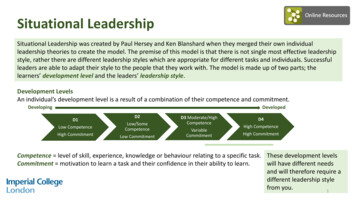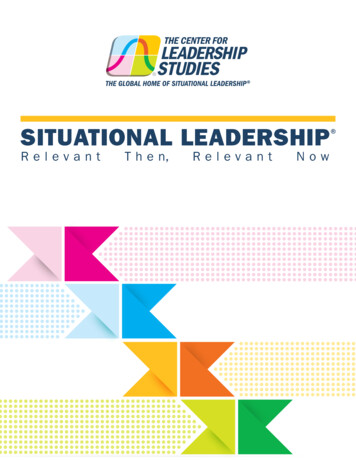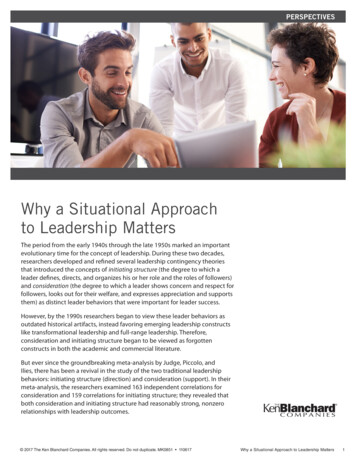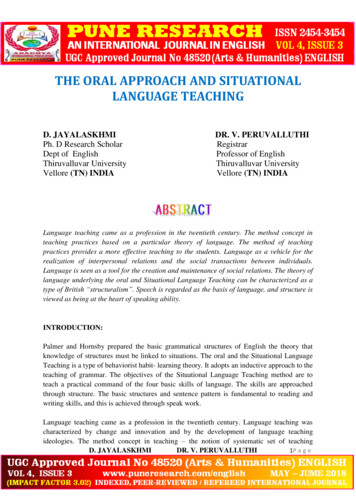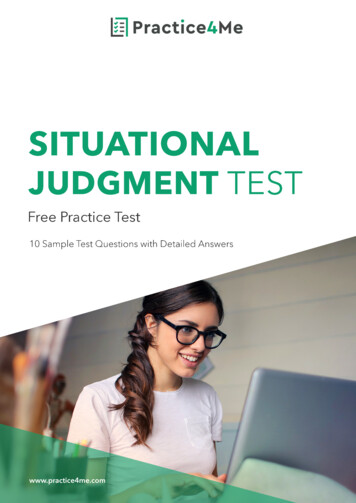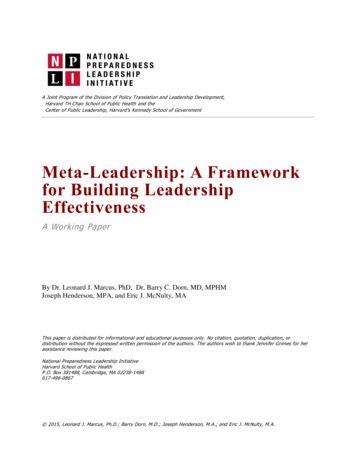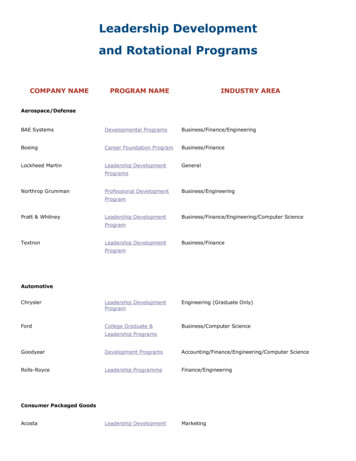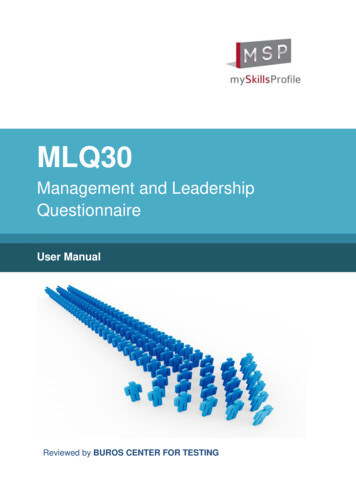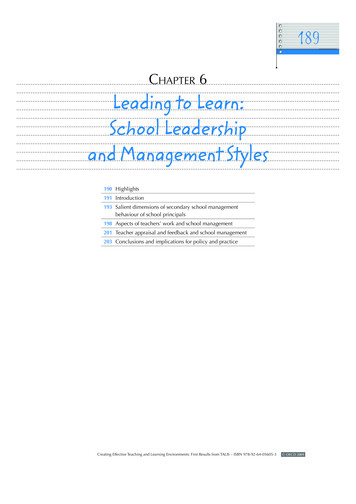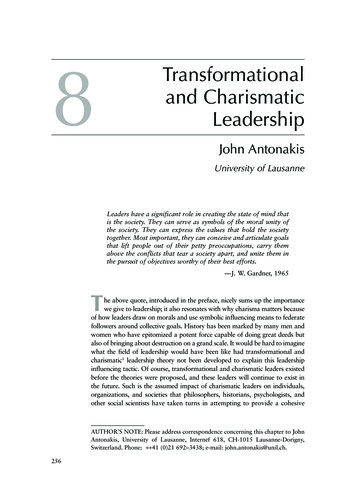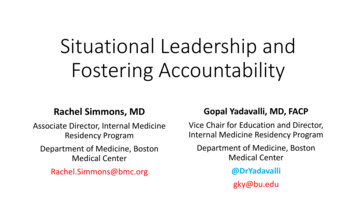
Transcription
Situational Leadership andFostering AccountabilityRachel Simmons, MDGopal Yadavalli, MD, FACPAssociate Director, Internal MedicineResidency ProgramDepartment of Medicine, BostonMedical CenterRachel.Simmons@bmc.orgVice Chair for Education and Director,Internal Medicine Residency ProgramDepartment of Medicine, BostonMedical Center@DrYadavalligky@bu.edu
Consider a vexing management situation Think of a time you have had a direct report or mentee who is not assuccessful as you’d would have liked in accomplishing a task/project Think of a time you have struggled in getting a direct report ormentee to get something going/show progress on a project/getsomething across the finish line Write this down
Learning Objectives Analyze situational leadership model of Hersey and Blanchard Apply situational leadership concepts to common managementchallenges in academic medicine Relate the Six Sources of Influence to accountability scenarios
SituationalLeadershipWhat is your leadership style?
Diagnosis Is the person willing? - commitment Is the person able? - competence Four Levels (developing to developed) D1: enthusiastic beginnerD2: disillusioned learnerD3: capable but cautious performerD4: self-reliant achiever
DirectingCoachingSupportingDelegatingDefines Roles andTasksDefines Roles andTasksCollaborativelydefines roles andtasksFollower definesroles and tasks1- waycommunicationfrom leader tofollowerSome 2-waycommunicationComplete 2-waycommunicationSome 2-waycommunicationSeeks no input;Provides little to noexplanationSeeks some inputSolicits full inputand sharesthoughts andopinionsProvides minimuminputCollaborativedecision-makingAbdicates decisionsto followerFacilitate & supporttaskaccomplishmentsLoosely monitorstaskaccomplishmentMakes all decisions Makes all decisionsfor followerbut explains themClosely supervises& directsClosely supervises& supportsprogressAdapted from www.workwithrichardp.com
Case 1: Oversee inpatient operations AB is an Associate Program Director you have hired to overseeinpatient operations for your program. He has no background in this,but has a successful history of epidemiological research and workingwell in team environments. At the first meeting, he asks what you would like to discuss. Youmention that there are hundreds of duty hour violations per month,and that this would be a good place to start. At the second meeting, he brings the updated duty hour violations tothe meeting, confirms that the problems persist, and asks for adviceon what to do.
Case 1, continued After 6 months, he comes to your weekly meeting with a full agenda:report on progress with changes in caps as well as some ideas onwhat to do about new issues on a cardiology service. After 9 months, you become aware that a new problem has surfacedon the heme/onc service and call him into the office to discuss. Heindicates that he is aware of the problem, has met with the chiefs todiscuss an action plan, has also developed a plan B, and – finally – hasidentified how you can help if plan B also is met with limited success.
Case 2: DOT for residents leading teams CD is a core faculty member you have hired to develop andimplement a direct observation tool (DOT) for PGY-2 residents leadingteams. This tool is anticipated to provide important information aswell as formative feedback about team management, teaching, andleadership skills that are not currently available in the programthrough other assessments. CD comes to the first meeting having done a literature search on DOTsfor residents in the morning rounds setting. She also has ideas onwhat additional assessments she can include in her own tool. In thesecond meeting, she brings a rough draft of the tool for review andfeedback. After 6 months, she has refined the tool and has piloted iton a couple of teams in preparation for a larger rollout.
Case 3: POCUS curriculum GH is a core faculty member you have hired to develop a newcurriculum in point-of-care ultrasound (POCUS), a major programpriority. At the first meeting, GH is eager and enthusiastic, but has nobackground in the area. You advise him to do some reading and referhim to a colleague in a different, local, institution who hasimplemented similar curricula in recent years. After 3 months, GH indicates that he has started a literature searchand has reached out to the outside colleague via email.
Case 3, continued After 6 months, GH has read some POCUS literature, has met with theoutside colleague, and asks if you think he should reach out to theBMC Emergency Department’s ultrasound faculty. After 9 months, GH reports that he reached out to the ED faculty theprior day via email and is waiting to hear back. He has also read acouple of more POCUS papers since your last meeting. At 12 months GH has met with the ED faculty, which he says has givenhim new directions to consider in the POCUS curriculum. He reflectsthat he has not yet produced a draft version of the curriculum, and islooking forward to more progress in the upcoming year.
Partnering Get agreement on SMART goals S: specific M: measurable, motivating A: attainable and aligned R: relevant T: trackable; time-anchored Matching Leadership Styles to Developmental Levels: explicitagreement
Consideringyour scenario: Identify the DevelopmentalLevel of the directreport/mentee Identify the relatedSituational Leadership levelyou should consider using Discuss
Accountability So you correctly assess the D level You take the right SL approach And you are still not seeing results. They are breaking theircommitment to you to get the thing done How do you keep them accountable?
Holding people accountableHow do you get them to do thething they said they’d do?
The “Accountability Matrix”:Why didn't they do the apted from CrucialAccountability and Influencer
StructuralSocialPersonalThe “Accountability Matrix”:Why didn’t they do the thing?MotivationAbilityDo they enjoy it?Is it painful?Are they actuallyable to do it?Do others motivate? Do others enable?Does the systemmotivate?Does the systemenable?*Adapted from CrucialAccountability and Influencer
AbilityMake the undesirabledesirableSurpass their limitsSocialHarness peer pressureFind strength innumbersDesign rewards anddemand accountabilityChange theenvironmentPersonalMotivationStructuralThe “Accountability Matrix”:How can we help them?*Adapted from CrucialAccountability and Influencer
MotivationAbilityPersonalDoes he enjoy it?Is it painful?Can he actually do it?SocialDo others motivate?Do others enable?StructuralThe “Accountability Matrix”:Why didn’t Gopal write the paper?Does the systemmotivate him?Does the systemenable him?*Adapted from CrucialAccountability and Influencer
AbilityMake the undesirabledesirableSurpass his limitsSocialHarness peer pressureFind strength innumbersDesign rewards anddemand accountabilityChange theenvironmentPersonalMotivationStructuralThe “Accountability Matrix”:How can we help Gopal?*Adapted from CrucialAccountability and Influencer
Case 5: Academic half day curriculum IJ is a junior faculty member you have hired to develop a newcurriculum in communication skills and conflict resolution. 4 months before the curriculum is set to role out, IJ has met withseveral people, is eager and has several ideas for the curriculum. She would like to ultimately submit the curriculum to MedEdPortaland asks you to mentor her through this process. You are excited thatIJ has thought about dissemination and is making her work counttwice! You have a meeting to discuss all the steps including reviewing whatexists in MedEdPortal, developing the workshop/curriculum, theassessment strategy, and IRB submission.
Case 5: Continued One month before the curriculum will launch, you have not heard from IJ.You send a quick email to check in. IJ replies that she will get back to you atthe end of the week. Three days before the first week of the curriculum. IJ sends you the slidesand asks for feedback. You give a few suggestions, but would have liked toreview in more detail and developed an assessment. You observe the workshop. IJ is an engaging educator. The workshop islively and interactive, and the residents rate it highly. Unprompted, the chief residents tell you how helpful IJ has been. She hasdone 3 conferences, precepted morning report, and has been contributingto both the Program Evaluation Committee and the ambulatory experiencecommittee. You also know she has done 10 interviews and recentlyvolunteered to organize grand rounds for your section. IJ meets with you to get feedback on the workshop. She expresses regretthat she was not able to do more to make it a MedEdPortal submission andasks for your advice.
StructuralSocialPersonalThe “Accountability Matrix”:Why didn’t they do the thing?MotivationAbilityDo they enjoy it?Is it painful?Are they actuallyable to do it?Do others motivate? Do others enable?Does the systemmotivate?Does the systemenable?*Adapted from CrucialAccountability and Influencer
AbilityMake the undesirabledesirableSurpass their limitsSocialHarness peer pressureFind strength innumbersDesign rewards anddemand accountabilityChange theenvironmentPersonalMotivationStructuralThe “Accountability Matrix”:How can we help them?*Adapted from CrucialAccountability and Influencer
Glamour work vs. Housework Lead to promotion Highly visible tasks/projects Non-promotable tasks Necessary but unsung
Consider joining the National Center forFaculty Development and Diversity Free through BU 14 day writing challenge Skill development Developing a strategic plan for the semester Sunday meetings: where your intentions meet your calendar Art of saying no
Consider your own accountability scenarios Can you put your problem into one or more boxes in the Matrix?
CPR: 3 step process Content Pattern Relationship
Thanks!
Appendices
Situational Leadership and Fostering Accountability Rachel Simmons, MD Associate Director, Internal Medicine Residency Program Department of Medicine, Boston Medical Center Rachel.Simmons@bmc.org Gopal Yadavalli, MD, FACP Vice Chair for Education and Director, Internal Medicine Residency Program Department of Medicine, Boston Medical Center @DrYadavalli
